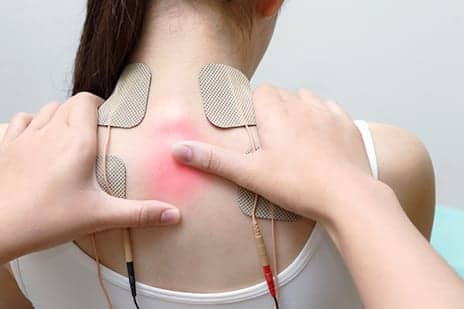By Cher Zavala
If you’re one of 100 million Americans who suffer from chronic pain, you can probably agree that pain is no fun to live with. But, while you may experience good days and bad days with your pain, there’s still much you can do to make the good days better and the bad days less frequent. Physical therapy can help you treat and manage chronic pain without the need for invasive surgeries or potentially addictive medications.
Physical therapy interventions treat pain in a number of ways. They can strengthen muscles and joints and help you learn to move and perform daily activities in ways that don’t aggravate old injuries or put you at risk of new ones. They can treat inflammation and address the movement dysfunction that’s at the core of much chronic pain. Finally, physical therapy can re-educate your central nervous system to make it less sensitive to pain signals. Let’s take a look at some of the physical therapy modalities and treatments that could ease your chronic pain.
Patient Education
Your physical therapist can’t be with you 24/7 to make sure you perform your exercises correctly, move in ways that protect you from re-injury, and make the best lifestyle choices to support your recovery from chronic pain. But that’s OK, because part of physical therapy is empowering the patient to take charge of his or her own recovery, through patient education.
Patient education can help you understand the value of the physical therapy treatments. For example, these Southern Michigan pain consultants will tell you, choosing the best treatment for pain requires understanding the source of the problem. One in 10 American adults – about 23.5 million people – deal with pain daily. Being educated in pain management truly gives more understanding on how to make healthy lifestyle choices going forward – it can help you decide what activities to include in your regular exercise routine, what foods to eat, what activities and movements to avoid, and how to best take care of yourself in general so that you can experience less pain. A physical therapist can teach you specialized techniques for everyday movement and activities, advise you on safely increasing your daily exercise, help you learn to pace yourself, and help you alter movement dysfunctions, like problems with gait or posture.
Exercise
Some physical therapy exercise is passive, meaning the patient just relaxes while the physical therapist moves or stretches one or more of his or her body parts. Some is active, meaning the patient has to do it under his or her own power. All exercise can be valuable for strengthening muscles, improving flexibility, increasing joint mobility, and strengthening the muscles around weak, painful joints to increase joint stability.
Manual Therapies
Manual therapies, also called bodywork, include many treatments that a therapist administers using his or her hands. Manual treatments can include massage, which eases pain and promotes healing by helping muscles relax and boosting circulation. Soft-tissue mobilization may be used to increase mobility around a joint by breaking up scar tissue, releasing tension, treating edema, and addressing myofascial adhesions, or fibrous areas of muscle tissue that have lost their elasticity. Direct manipulation of joints can be used to restore alignment and improve functioning.
Transcutaneous Electrical Nerve Stimulation
Transcutaneous electrical nerve stimulation, or TENS, uses low-voltage electrical currents to stimulate an injured or painful area for pain relief. The electricity is administered through electrodes attached to your skin. How does this work to relieve pain? It’s thought that the electrical stimulation from the electrodes intercepts pain signals from the nerves in that area, lessening the experience of pain. The electrical stimulation may also boost the production of endorphins, neurotransmitters which serve as natural painkillers.
Hot and Cold Therapies
Hot and cold therapies include the application of heat or cold to the painful area to reduce inflammation, relieve pain, and promote healing. Hot and cold therapies can include:
- The use of hot packs to deliver moist heat to the painful area, to increase circulation, relax muscles, and relieve pain;
- The use of hot or cold whirlpool baths to improve circulation and control swelling or inflammation;
- The use of ultrasound to apply deep heat to muscles, bones, and tendons;
- The use of ice packs to limit swelling and ease soreness.
Graded Motor Imagery
Graded motor imagery, or GMI, is a chronic pain treatment that uses your brain’s own plasticity and neural connections to treat your chronic pain. The therapy uses techniques such as visualizing movement without actually moving, using mirrors to trick your brain into thinking that you’re moving a weaker or painful body part when you’re actually moving a stronger body part, and using left-right discrimination exercises to recalibrate crucial parts of your brain that help in pain recovery. GMI helps you regain confidence in your physical strength and relearn motor control, while reconfiguring how you respond to pain.
Sensory Re-Education
When you suffer a serious injury or illness, chronic pain can occur when the nervous system, overwhelmed by constant, severe pain signals, goes haywire and continues to sense pain even after the injury has healed. Sensory re-education for chronic pain can help desensitize your nervous system to these pain signals so that they are no longer overwhelming. The re-education protocol usually uses light stimuli on both the unaffected and affected areas, so that the brain can begin to compare sensations in these two areas and decrease sensitivity in the affected area.
Many physical therapy interventions can treat or even completely relieve chronic pain, without the need for surgery or drugs. If you suffer from chronic pain, don’t give up. With the right treatment, you, too, could once again enjoy a life without pain.
Cher Zevala is a content coordinator specializing in topics associated with the healthcare industry and innovations in the healthcare field. She is a contributing writer to Physical Therapy Products. For more information, contact [email protected].








Hello.
I am interested in writing a guest post for your blog. Are you currently accepting
guest post.
Regard’s Angela.For a guest post.